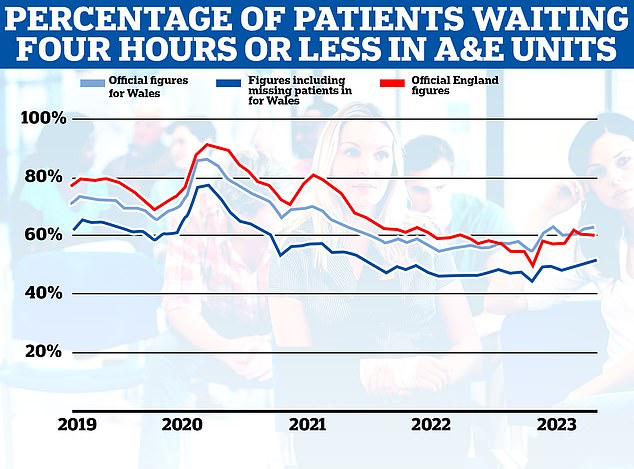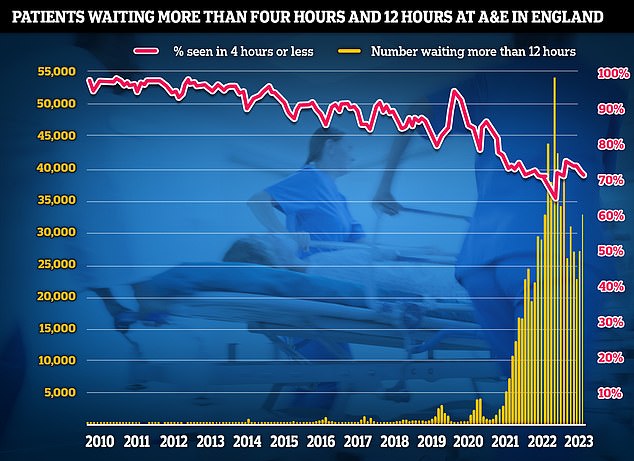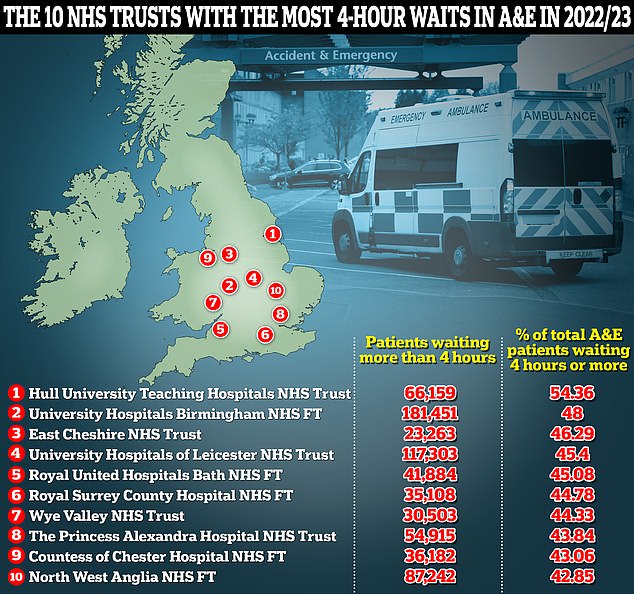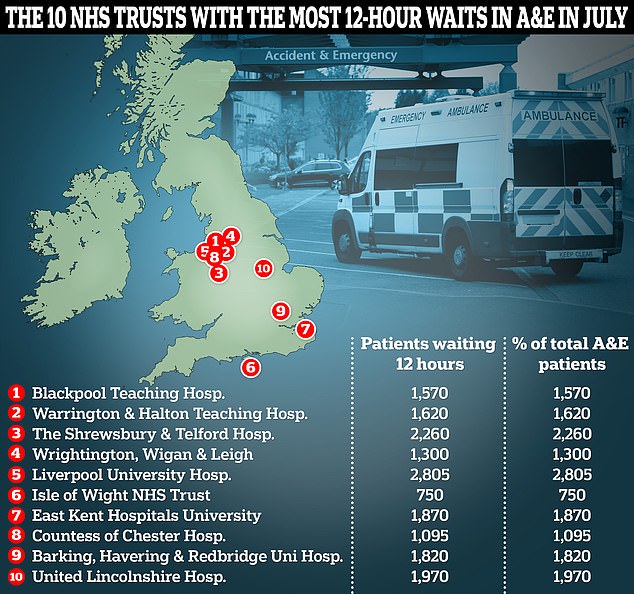Proof a Labour-run NHS would NOT be any better? Outrage over A&E waiting times ‘scandal’ in Wales as it’s revealed hospitals have massively under-counted true situation for 10 years (and it means England IS faring better)
The Tories today accused Labor of ‘hiding’ the true reality of serious emergency department delays, after it emerged that waiting times in Wales have been vastly under-reported over the past decade.
This year alone, around 45,000 patients requiring at least four hours in hospital were quietly removed from official statistics due to a loophole.
It meant that the Labour-led Welsh government could boast that its A&E units were ‘outperforming’ those in England.
But analysis by the Royal College of Emergency Medicine suggests the opposite is true.
Before the missing figures came to light, official data showed that 39 per cent of all emergency department patients in Wales had to wait four hours before being admitted, transferred or discharged in April this year.

A study has found that Welsh emergency departments are under-reporting the number of patients forced to wait four hours or more for years in officially published data (light blue line) and when this is taken into account, performance (dark blue line) actually worse than those in England. (Red line)

Of the 2.1 million visitors to the emergency department in September, three in ten (28.4 percent) had to wait more than four hours to be seen (red line). Additionally, 33,107 patients waited more than 12 hours (yellow bars), the highest figure in six months and an increase of 14.7 percent compared to a month earlier
By comparison, the corresponding figure in the NHS in England – controlled by the Tories since 2010 – was around 41 per cent that month.
But when missing patients are taken into account, the actual performance of emergency departments in Wales was almost 51 per cent.
According to the NHS targets, this should not exceed 5 percent.
Tory MP David TC Davies, who serves as Welsh Secretary, said the results of the RCEM investigation were ‘shameful and disgraceful’.
He told the BBC: ‘Time and time again, the Labour-led Welsh Government has seriously failed our NHS in Wales.
‘Resolving this latest scandal is a priority for the people of Wales, and I call on Labor to finally listen to them.’
Health Secretary Steve Barclay wrote on
‘But it turns out they hid 45,000 patients from the figures.
‘Whether for elective surgery or emergency care, patients in Labour-run Wales are waiting longer.’
However, the Welsh Government has disputed the conclusions of the RCEM analysis.
The RCEM found that NHS health boards in Wales were excluding patients who fell under the ‘fracture exemption’ classification.
It covers patients waiting for additional information or treatment in the emergency room, such as patients waiting for test results before a decision is made to admit or discharge them, or waiting for a cast to be applied.
In 2011, ‘breach exemptions’ were introduced to stop hospitals from rushing patients into Welsh emergency departments to meet performance targets.
But the RCEM said the figures have been used to underreport the country’s long emergency room wait times.
Leading experts warned that this could impact critical safety aspects within the NHS, such as staffing planning.
The council said the new data showed that 45,000 patients were excluded from Welsh A&E data between January and June this year alone, but the problem had been going on for more than a decade.
When this data was taken into account, it was found that more than 670,000 patients were missing from the published data between January 2012 and June this year.
This amounts to approximately one fifth of the total number of patients seen in the emergency department during that period.
Dr. Suresh Pillai, RCEM vice president for Wales, said: “WWe have repeatedly asked for “infringement exemptions” to be included in the official statistics.

This map shows the 10 NHS trusts where the largest proportion of A&E patients are forced to wait more than four hours before being admitted, transferred or discharged

This graph shows the 10 NHS trusts with the highest proportion of A&E patients who waited more than 12 hours before being admitted, transferred or discharged
“To leave them out is to misrepresent the issue and not give the full picture.”
He added: “If you don’t count those patients in the already overcrowded emergency department, we can’t measure how bad things are.
‘If you don’t get the real numbers, the perception would be: ‘everything is fine’. While in reality that is not the case.
“This is critical as we plan and prepare for what looks to be another extremely challenging winter.”
A Welsh Government spokesperson said they dispute the RCEM’s conclusions.
“Welsh Health Boards have confirmed that exceptions to breaches have been included in the monthly data, in line with guidance issued in 2011,” they said.
‘We have seen no evidence to support the RCEM and BBC’s suggestion that there is under-reporting or that our data is not comparable with other parts of Britain.’
Welsh ministers have previously been keen to boast that their A&Es were performing better than England’s.
In March this year, Welsh Secretary for Health and Social Services Eluned Morgan said: ‘This is the sixth consecutive month that performance in major emergency departments in Wales has improved on English performance.’
And just last week, Ms Morgan issued a press release citing official NHS data showing that Welsh A&Es had ‘outperformed’ their English counterparts.
The argument that Welsh A&Es were performing better than those under the English Tories was used to counter attacks on waiting times in Wales.
Data from earlier this year showed that patients in Wales wait an average of five weeks longer for NHS treatment than in England.
Some Welsh patients are even fleeing to England for treatment due to delays.
However, England is also far behind in A&E performance targets.
Of the 2.1 million emergency room visitors in September, three in ten (28.4 percent) had to wait more than four hours to be seen, according to the latest available data.
The four-hour waiting target has not been achieved nationally for ten years.
In addition, 33,107 shocking patients waited more than 12 hours – more than 70 times more than before Covid took off.
But even this is an underestimate, as officials were asked to clarify the reality of the situation earlier this year.
The figures record the wait for the trolley: the time between doctors deciding that a patient needs to be admitted and the moment they get a bed.
When patient waiting times are recorded as soon as they arrive at the emergency room, the actual situation is about three times worse.
These are national figures and MailOnline analysis has shown that the situation is much worse in some individual NHS trusts.
England’s emergency room crisis has become so severe that the NHS has effectively abandoned its 95 per cent four-hour target by the end of 2022.
Instead, health chiefs have been told to focus instead on an ‘interim target’ of seeing 76 per cent of patients within four hours by March next year.
But last month this website revealed that the vast majority of NHS A&E departments do not meet even this reduced threshold.
